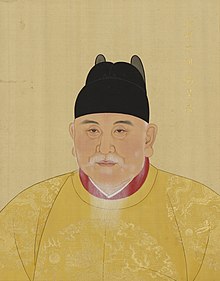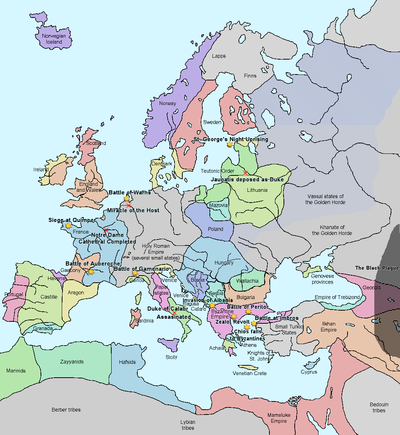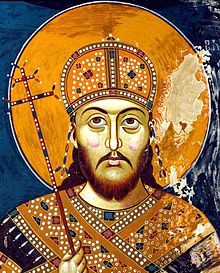1345
| Millennium: | 2nd millennium |
|---|---|
| Centuries: | |
| Decades: | |
| Years: |
|
| 1345 by topic |
|---|
| Leaders |
|
| Birth and death categories |
| Births – Deaths |
| Establishments and disestablishments categories |
| Establishments – Disestablishments |
| Art and literature |
|
1345 in poetry |
| 567 before ROC 民前567年 | |
| Nanakshahi calendar | −123 |
| Thai solar calendar | 1887–1888 |
| Tibetan calendar | 阳木猴年 (male Wood-Monkey) 1471 or 1090 or 318 — to — 阴木鸡年 (female Wood-Rooster) 1472 or 1091 or 319 |
Year 1345 (MCCCXLV) was a common year starting on Saturday (link will display the full calendar) of the Julian calendar. It was a year in the 14th century, in the midst of a period in human history often referred to as the Late Middle Ages
During this year on the Asian continent, several divisions of the old
The main forces in the
Turks clashed with Byzantines, Serbs, and Cypriots at sea and in the islands of Chios and Imbros. The Byzantine Empire's precarious situation at this time is evidenced by the fact that they did not have enough soldiers to protect their own borders, but hired mercenaries from the Serbs and the Ottoman Turks.
Events
- January 17 – The Turks attack Smyrna.
- Miracle of the Host occurs (as commemorated in Amsterdam).
- April – Edward III of England offers "defiance" of Philip VI of France.
- April 22 – Battle of Gamenario: The Lombards defeat the Angevins in the northwest region of present-day Italy, just southeast of Turin.
- Umur Beg, sail from Asia Minor to the Balkan Peninsula, and raid Bulgarian territory.[3]
- "Summer" (undated) – Louis IV's son, Louis VI the Roman, marries Cunigunde, a Lithuanian princess.[4]
- July 7 – Battle of Peritheorion: the forces of Momchil, autonomous ruler of the Rhodope, are defeated by the Turkish allies of John VI Kantakouzenos.[5]
- August – Gascon campaign of 1345 - Battle of Bergerac, Gascony: English troops are victorious over the French. [6]
- September – Holland, Hainaut and Zeeland are inherited by Louis IV, Holy Roman Emperor, and remain part of the imperial crown domain until 1347.
- September 18 – Andrew, Duke of Calabria, is assassinated in Naples (d. in Aversa).
- September 26 – Battle of Warns: The Frisians defeat the forces of Holland under William II, Count of Hainaut, in the midst of the Friso-Hollandic Wars.[7]
- October 21 – Battle of Auberoche in Gascony: The English defeat the French.[8]
- November 8 – The English take La Réole in Gascony.[9]
- December – The English take Aiguillon in Gascony.
Asia

Western Asia
The country of Georgia had been struggling for independence from the Ilkhanate since the first anti-Mongol uprising started in 1259 under the leadership of King David Narin who in fact waged his war for almost thirty years. Finally, it was King George the Brilliant (1314–1346) who managed to play on the decline of the Ilkhanate, stopped paying tribute to the Mongols, restored the pre-1220 state borders of Georgia, and returned the Empire of Trebizond into Georgia's sphere of influence. Thus, in 1345, Georgia was in the midst of golden age of independence, though its leader would die one year later.
Trebizond had reached its greatest wealth and influence during the long reign of
Mongol khanates
The Mongol Empire had become fractured since the late 13th century. After the death of Kublai Khan in 1294, it had already been divided into four khanates: The Yuan dynasty, the Ilkhanate, the Golden Horde, and the Chagatai Khanate.

Ilkhanate
The
Golden Horde
In 1345, the
The Kingdom of Hungary saw the threat of the growing power of the Golden Horde and as such, in 1345 it began a campaign against the Tatars and the Horde, in the area what would become a few years later Moldavia. Andrew Lackfi, the Voivode of Transylvania and his Székely warriors were victorious in their campaign, decapitating the local Tatar leader, the brother-in-law of the Khan, Atlamïş and making the Tatars flee toward the coastal area.[12]
Chagatai Khanate

Yuan dynasty
By 1345, the
Japan and India
From 1336 to 1392, two courts claimed the throne of
Southeast Asia
In Southeast Asia, Sukhothai changed hands to a new Siamese dynasty in 1345.[18] A Buddhist work, the Traibhumikatha, was composed by the King of Siam in the same year.[19] The Sukhothai Emperor also wrote a similar Buddhist work, the Tri Phum Phra Ruang. Both works describe Southeast Asian cosmological ideas which still exist today. Life is said in these books to be divided into 31 levels of existence separated between three worlds.[20] Angkor was in a period of decline, forced to devote much of its resources to skirmishes with the Sukhothai and Siamese, which left Champa free to attack Đại Việt and opened the way for Lopburi to spring up, all of which happened right around this year.[21] A Buddhist colony also existed to the west in the Mon Empire, which struggled to maintain its existence in the face of the Islamic Delhi Sultanate to the west and the Mongol Chinese to the north.
The Majapahit Empire, which occupied much of the
Western Europe

Hundred Years' War
By 1345, the
A new machine was introduced to this war in 1345—cannon. "Ribaldis", as they were then called, are first mentioned in the English Privy Wardrobe accounts during preparations for the Battle of Crécy between 1345 and 1346.[23] These were believed to have shot large arrows and simplistic grapeshot, but they were so important they were directly controlled by the Royal Wardrobe.[23]
War of Succession
A kind of side conflict to the Hundred Years' War was the War of the Breton Succession, a conflict between the Houses of Blois and Montfort for control of the Duchy of Brittany. The French backed Blois and the English backed Montfort in what became a miniature of the wider conflict between the two countries. The House of Blois had laid siege to the town of Quimper in early 1344, and continued into 1345. During the summer and autumn of 1344, the Montfortist party had fallen apart. Even those who had been John of Montfort's staunchest allies now considered it futile to continue the struggle. It therefore mattered little that in March 1345 John finally managed to escape to England. With no adherents of note of his own, he was now little more than a figurehead for English ambitions in Brittany.
Edward III decided to repudiate the truce in summer 1345, a year before it was due to run out. As part of his larger strategy, a force was dispatched to Brittany under the joint leadership of the Earl of Northampton and John of Montfort. Within a week of their landing in June, the English had their first victory when Sir Thomas Dagworth, one of Northampton's lieutenants, raided central Brittany and defeated Charles of Blois at Cadoret near Josselin.
The follow-up was less impressive. Further operations were delayed until July when Montfort attempted the recapture of Quimper. However, news had reached the French government that Edward's main campaign had been cancelled and they were able to send reinforcements from Normandy. With his strengthened army, Charles of Blois broke the siege. Routed, Montfort fled back to Hennebont where he fell ill and died 16 September. The heir to the Montfortist cause was his 5-year-old son, John.
During the winter, Northampton fought a long and hard winter campaign with the apparent objective of seizing a harbour on the north side of the peninsula. Edward III had probably planned to land here with his main force during summer 1346. However, the English achieved very little for their efforts. Northern Brittany was Joanna of Dreux’ home region and resistance here was stiff. The only bright spot for the English was victory at the Battle of La Roche-Derrien, where the small town was captured and a garrison installed under Richard Totesham.

Other events
Also in England in 1345,

Besides the War of Succession and the Hundred Years' War, France was in the midst of an interesting period. Several decades earlier, the Roman Papacy had moved to Avignon and would not return to Rome for another 33 years. The
Central Europe

Holy Roman Empire
On 1 January, emperor
On 12 March, a
Holland, meanwhile, was in the midst of the
William's troops set fire to the abandoned villages of Laaxum and
Italy
The
In the aftermath, Piedmont was partitioned between the victors. John received Alba,
Thus, in 1345, hearing of the Pope's reversal, a group of noble conspirators (probably including Queen Joan) determined to forestall Andrew's coronation. During a hunting trip at Aversa, Andrew left his room in the middle of the night and was set upon by the conspirators. A treacherous servant barred the door behind him; and as Joan cowered in their bed, a terrible struggle ensued, Andrew defending himself furiously and shrieking for aid. He was finally overpowered, strangled with a cord, and flung from a window. The horrible deed would taint the rest of Joan's reign.
Other events in Italy in 1345 include
Sweden and Lithuania

In Sweden and states bordering the
Records also exist for the emigration of Swedes to
1345 marked the end of a series of skirmishes begun in the 1343
In Lithuania in 1345
Balkans

In 1345, the
The first known line of Serbian text written in the Latin alphabet is dated to this year. Serbia was recognized as the most powerful empire in the Balkans for the next several years.The Byzantine civil war also allowed the emergence of a local quasi-independent principality in the
On 11 June,
...one after another the prisoners were hurled from the walls of the citadel and hacked to pieces by the mob of the Zealots assembled below. Then followed a hunt for all the members of the upper classes: they were driven through the streets like slaves, with ropes round their necks-here a servant dragged his master, there a slave his purchaser, while the peasant struck the strategus and the labourer beat the soldier (i.e. the pronoiar).[38]

In 1345, the Greek island of Chios fell to the Genoese Giustiniani. The Genoese also sacked the city of Dvigrad in Istria in this same year. Aquileian patriarchs had for some time fought fiercely against Venetians which had already gained considerable influence on the west coast of Istria. It was during these confrontations that the town fell.
Anatolian Peninsula
In 1344,
John XIV sparked the civil conflict when he convinced the Empress that John V's rule was threatened by the ambitions of Kantakouzenos. In September 1341, whilst Kantakouzenos was in Thrace, Kalekas declared himself as regent and launched a vicious attack on Kantakouzenos, his supporters & family.[40] In October Anna ordered Kantakouzenos to resign his command.[41] Kantakouzenos not only refused, he declared himself Emperor at Didymoteichon, allegedly to protect John V's rule from Kalekas. Whether or not Kantakouzenos wished to be Emperor is not known, but the provocative actions of the Patriarch forced Kantakouzenos to fight to retain his power and start the civil war.
There were not nearly enough troops to defend Byzantium's borders at the time and there certainly was not enough for the two factions to split – consequently, more foreigners would flood the Empire into a state of chaos – Kantakouzenos hired Turks and Serbs – his main supply of Turkish mercenaries came from the Umur of Aydin,[42] a nominal ally established by Andronikos III. The Regency of John V relied on Turkish mercenaries as well.[42] However, Kantakouzenos began to draw support from the Ottoman Sultan Orkhan, who wed Kantakouzenos' daughter in 1345.[42] By 1347, Kantakouzenos had triumphed and entered Constantinople. However, in his hour of victory, he came to an accord with Anna and her son, John V. John V (now 15 years of age) and Kantakouzenos would rule as co-emperors, though John V would be the junior in this relationship.[42] The unlikely peace would not last long.
The Turks attacked Smyrna on January 17 and the Ottomans annexed Qarasi in west Asia minor.[43] Later, Pope Clement urged further attacks on the Levant.[44]
Africa
Births
- January 8 – Kadi Burhan al-Din, poet, kadi, and ruler of Sivas (d. 1398)[47]
- John of Gaunt, 1st Duke of Lancaster (d. 1369)
- Fernando I of Portugal (d. 1383)
- December 7 – Thado Minbya, founder of the Ava kingdom (d. 1367)
- date unknown
- King Charles III of Naples, reign 1381–1386 (d. 1386)
- Eleanor Maltravers, English noblewoman (d. 1405)
- John Wolflin (d. 1393)
- Queen Helen of Bosnia (d. 1399)
Deaths
- January 17
- Lord of Chios(killed by Turks at Smyrna)
- Latin Patriarch of Constantinople(killed by Turks at Smyrna)
- September 18 – Andrew, Duke of Calabria (b. 1327)
- September 22 – Henry, 3rd Earl of Lancaster, English politician (b. 1281)
- Richard Aungerville (also known as Richard De Bury), English writer and bishop (b. 1287)
- June 11 – Alexios Apokaukos, chief minister of the Byzantine Empire (lynched by political prisoners)
- July 7 – Momchil, semi-independent brigand ruler in the Rhodope Mountains (killed in battle)
- July 24 – Jacob van Artevelde, Flemish statesman (b. 1290) (killed by mob)
- July 28 – Sancia of Majorca, queen regent of Naples (b. c. 1285)
- September 26 – William II, Count of Hainaut (killed in the Battle of Warns)
- Pedro I of Portugal (b. 1323)
- date unknown
- King of Connacht
- John Vatatzes, Byzantine general (murdered)
- John Apokaukos, governor of Thessalonica (executed)
References
- ^ a b pgs. 143–148 ASIN B000K6TDP2
- ^ ISBN 978-0-7190-3498-5pg.104–105
- ^ Ioannes Cantacuzenus. Historiarum... 2, p.530
- ISBN 9789004466555.
- ^ Nicephorus Gregoras. Byzantina historia. 2, p.729
- ISBN 978-0-571-20095-5, p. 465.
- ^ E. Howard Harris (1956). The Literature of Friesland. Van Gorcum & Comp. p. 13.
- ISBN 978-0-571-20095-5, pp. 467–470.
- ISBN 978-0-571-20095-5, p. 474.
- ^ William Miller (1968). Trebizond: The Last Greek Empire. A. M. Hakkert. p. 36.
- ^ William Miller (1968). Trebizond: The Last Greek Empire. A. M. Hakkert. p. 52.
- ^ István Vásáry, Cumans and Tatars, Cambridge University Press, 2005, p. 156.
- ISBN 978-0-521-34595-8.
- ^ "Mongol Yuan Dynasty -- Political, Social, Cultural, Historical Analysis Of China". www.imperialchina.org.
- ISBN 978-0-87332-452-6. 149.
- ^ Demetrius Charles de Kavanagh Boulger. 1900. A Short History of China. New York: F.P. Harper, p. 79
- ^ Morris, Charles. 1904 Historical Tales, the Romance of Reality: Japan and China. New York, Los Angeles: R.H. Whitten Company. p. 265
- ISBN 978-1-903471-39-5pg. 247
- ISBN 978-81-208-0272-8pg. 120
- ISBN 978-0-8387-5139-8pg. 26
- ISBN 978-0-521-80086-0pgs. 236–7
- ISBN 978-81-208-0403-6pg. 376
- ^ ISBN 978-1-85532-966-9
- ISBN 978-0-8122-1889-3pg. 212
- ISBN 978-0-415-28525-4pg. 102
- ISBN 978-1-4304-7125-7pgs. 53–54.
- ISBN 978-1-4042-2909-9pg. 126
- ^ Giuseppe Cerrato: "In Atti della Società ligure di storia patria" – S. 2, vol. 17 (1885), p. 382–542
- ^ «Studi Piemontesi»: VII (1978), 2, pp. 341–51
- ^ Kupfer, M; "The lost wheel map of Ambrogio Lorenzetti", The Art Bulletin, June 1996. Retrieved 2 January 2007.
- ^ ISBN 978-0-521-45011-9.
- ISBN 978-9986-810-13-1.
- ISBN 978-0-472-08260-5.
- ISBN 978-0-472-08260-5.
- ^ Lemerle, P. L'emirat d'Aydin..., p.210, 217
- ISBN 978-0-521-43991-6.
- ISBN 978-0-472-08260-5.
- Patrologia Graecae, 109.
- ^ Dr. Hans Theunissen (1998). "Venice and the Turcoman Begliks of Menteşe and Aydın, Section V of "Ottoman-Venetian diplomatics, the Ahd-Names"" (PDF). Netherlands: Leiden University. Archived from the original (PDF) on April 29, 2005. Retrieved February 21, 2007.
- ISBN 978-0-297-77747-2.
- ISBN 978-0-297-77747-2.
- ^ ISBN 978-0-297-77747-2.
- ISBN 978-0-8122-1889-3pg. 191
- ISBN 978-0-87169-114-9pg. 455
- ISBN 978-0-8122-1889-3pg. 212
- ISBN 978-0-8133-4355-6pg. 65
- OCLC 495469456.
